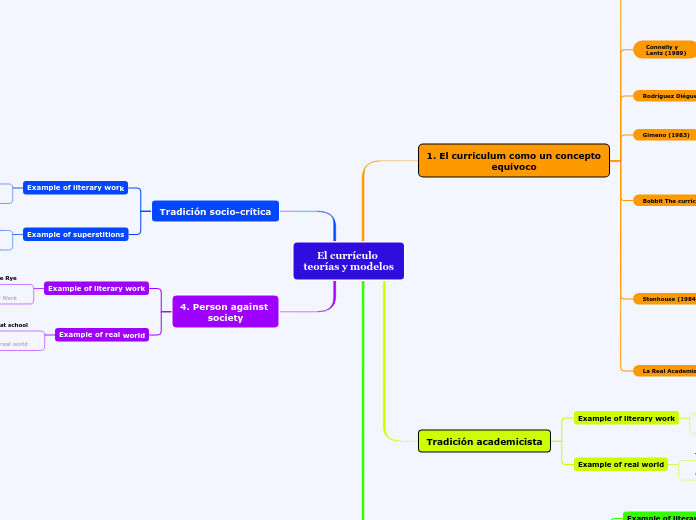El currículo
teorías y modelos
Conflict is present everywhere in the world around us. We experience conflict on a daily basis, and it can be minor or major.
Conflict in a story is a struggle between opposing forces. Characters must act to confront those forces and there is where conflict is born. If there is nothing to overcome, there is no story. Conflict in a story creates and drives the plot forward.
4. Person against
society
In this type of conflict, a character must take on society itself, and not a single person. The character stands at odds with societal norms and realizes the necessity to work against these norms. This is an external conflict.
Give examples of man versus society conflict in the real world.
A loner struggling to fit in at school
Give examples of man versus society conflict in a literary work.
J. D. Salinger - The Catcher in the Rye
Tradición socio-crítica
This situation results from a protagonist working against what has been foretold for that person. While this conflict was more prevalent in stories where gods could control fate, such as in ancient Greek dramas, there are still examples of this type of conflict in more contemporary literature.
Example of superstitions
Since in real life we can't say that such examples of man versus supernatural, there are some superstitions that can influence a person's life.
Give examples of these superstitions.
Superstitions
Black cat crossing your path
Give examples of man versus fate conflict in a literary work.
Daniel Defoe - Robinson Crusoe
Tradición tecnológico-positivista
This conflict develops from a protagonist’s inner struggles and may depend on a character trying to decide between good and evil or overcoming self-doubt. This conflict has both internal and external aspects, as obstacles outside the protagonist's force them to deal with inner issues.
Give examples of man versus self conflict in the real world.
A stutterer preparing for a public speech
Give examples of man versus self conflict in a literary work.
William Shakespeare - Hamlet
Tradición academicista
In this type of conflict, a character is tormented by natural forces such as storms or animals. This is also an external conflict.
Example of real world
Give examples of man versus nature conflict in the real world.
Conflict of real world
Trying to summit Mount Everest
Example of literary work
Give examples of man versus nature conflict in a literary work.
Literary Work
Ernest Hemingway - The Old Man and the Sea
1. El currículum como un concepto equívoco
A situation in which two characters have opposing desires or interests. The typical scenario is a conflict between the protagonist and antagonist. This is an external conflict.
La Real Academia Española (1984)
define como «conjunto de estudios y prácticas destinadas a que el alumno desarrolle
plenamente sus posibilidades».
Stenhouse (1984)
En el siglo XIX el currículum es definido como «estructura organizativa de conocimientos» impuesta por las autoridades políticas y académicas para poner orden en la escuela y reconducir su manera de actuar.
Registra su uso desde el siglo XVII, En un primer momento el concepto currículum se refiere a estudios en la Universidad o College y posteriormente se generaliza a otros niveles.
afirma que el Shorter Oxford Dictionary define currículum como un «curso, en especial un curso regular, de estudios en
una escuela o una universidad.
Bobbit The curriculum (1918)
En ambos casos el uso del término currículum está ligado a la Reforma Protestante y a la necesidad de controlar administrativamente los estudios que se ofrecen a los clérigos por parte del estado
How to make a curriculum (1924)
El primero que cita este concepto y lo utiliza en un título. No obstante, Hamilton (1989) encuentra su primer uso en 1582 en Leiden y en 1633 en Glasgow designando un curso o cuerpo de cursos ofrecidos en una institución educativa.
Gimeno (1983)
Afirma la existencia de una confusión conceptual y terminológica en torno al concepto currículum, que abarca «desde la restrictiva alusión al término currículum como un programa estructurado de contenidos disciplinares, hasta su
laxa consideración como el conjunto de toda la experiencia que tiene el niño bajo la tutela de la escuela»
Rodríguez Diéguez (1985)
Indica que resulta un término polisémico, aunque reconoce que en la mayoría de los autores subyace la idea de planificación, tratando de buscar sentidos diferentes
Connelly y
Lantz (1989)
Existenciales-Personales
(visión vitalista del mismo)
Medios-Fines
(dimensión tecnológica del currículum)
La tarea de definir el currículum como cultura escolar es compleja y difícil debido a la ambigüedad del concepto currículum. Hay cuatro grandes modelos curriculares
Give examples of man versus man conflict in a literary work.
Socio-Crítico
Cognitivo Simbólico
Tecnológico-Positivista
Academicista









